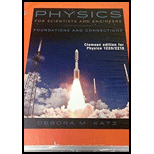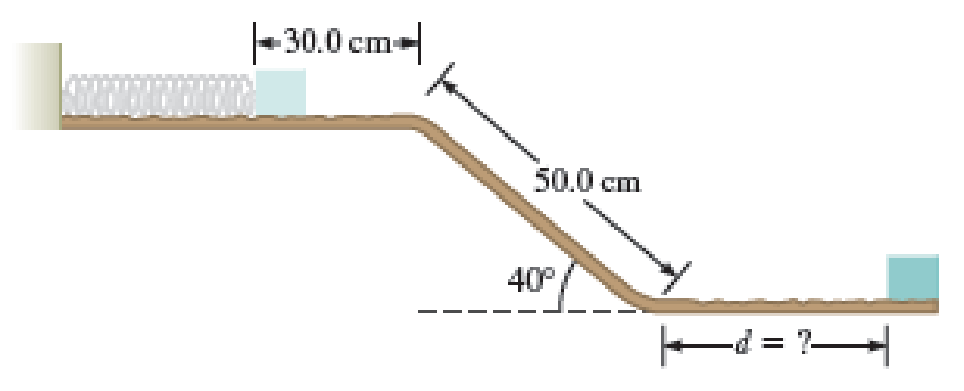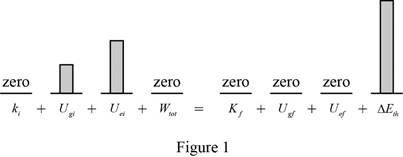
Concept explainers
A small 0.65-kg box is launched from rest by a horizontal spring as shown in Figure P9.50. The block slides on a track down a hill and comes to rest at a distance d from the base of the hill. Kinetic friction between the box and the track is negligible on the hill, but the coefficient of kinetic friction between the box and the horizontal parts of track is 0.35. The spring has a spring constant of 34.5 N/m, and is compressed 30.0 cm with the box attached. The block remains on the track at all times.
a. What would you include in the system? Explain your choice.
b. Calculate d.

(a)
The items included in the system and explain the choice.
Answer to Problem 50PQ
The items included are the box and the tracks surface because the kinetic friction increases the thermal energies and included this thermal energy internal to the system.
Explanation of Solution
In order to keep all the thermal energy into the system, it is better to include both the box and the tracks surface so that it will increase the kinetic friction which leads to the increase in the thermal energies and including both keeps all of this thermal energy internal to the system.
If Earth and spring are the choices, to account for them in terms of changes in gravitational and elastic potential energy without letting anything outside the system to do work.
Figure 1 show the graph of the initial and final energies which will help to organize the energies needed to be taken into account.

Conclusion:
Therefore, the items included are box and the tracks surface because the kinetic friction increases the thermal energies and included this thermal energy internal to the system.
(b)
The value of
Answer to Problem 50PQ
The value of
Explanation of Solution
The reference configuration for the spring is when it is relaxed, and for gravity it is when the box is at the bottom of the ramp. The box is initially at rest
The energy conservation equation for a system is,
Here,
In this problem, Equation (I) will changes to (since all other energies are zero),
Write the expression for the initial gravitational potential energy.
Here,
Write the expression for the initial potential energy of the spring.
Here,
Write the expression for the thermal energy.
Here,
The total path length will be
Kinetic friction is proportional to the normal force which equals the weight.
Here,
Write the expression for the normal force.
Use equation (VIII) in equation (VI),
Use equation (VIII) in (VI), and solve for
Conclusion:
The displacement
Substitute
Therefore, the value of
Want to see more full solutions like this?
Chapter 9 Solutions
Physics for Scientists and Engineers: Foundations and Connections
- Which of the following laws is true regarding tensile strength? • tensile strength T ①Fbreak = Wtfest Piece thickness rate (mm) ②T = test piece width rabe (mm) Fbreak break watarrow_forwardThe position of a squirrel running in a park is given by = [(0.280 m/s)t + (0.0360 m/s²)t²] + (0.0190 m/s³)ť³ĵj. What is v₂(t), the x-component of the velocity of the squirrel, as a function of time?arrow_forwardNo chatgpt pls will upvotearrow_forward
- You hold a spherical salad bowl 85 cm in front of your face with the bottom of the bowl facing you. The salad bowl is made of polished metal with a 40 cm radius of curvature. Where is the image of your 2.0 cm tall nose located? What is image's size, orientation, and nature. I keep getting the answer -26.2, but it keeps saying it is wrong. I just want to know what i'm doing wrong.arrow_forwardA converging lens with a focal length of 6.70 cm forms an image of a 4.60 mm tall real object that is to the left of the lens. The image is 1.50 cm tall and erect. Where are the object and image located? Is the image real or virtual? Please show all stepsarrow_forwardNo chatgpt pls will upvotearrow_forward
- need help part earrow_forwardCritical damping is the case where the mass never actually crosses over equilibrium position, but reaches equilibrium as fast as possible. Experiment with changing c to find the critical damping constant. Use the same initial conditions as in the last problem. Zoom in a bit to make sure you don't allow any oscillations to take place - even small ones.arrow_forwardNASA's KC-135 Reduced Gravity Research aircraft, affectionately known as the "Vomit Comet," is used in training astronauts and testing equipment for microgravity environments. During a typical mission, the aircraft makes approximately 30 to 40 parabolic arcs. During each arc, the aircraft and objects inside it are in free-fall, and passengers float freely in apparent "weightlessness." The figure below shows the altitude of the aircraft during a typical mission. It climbs from 24,000 ft to 30,850 ft, where it begins a parabolic arc with a velocity of 155 m/s at 45.0° nose-high and exits with velocity 155 m/s at 45.0° nose-low. 31 000 45° nose high 45° nose low 24 000 Zero g 65 Maneuver time (s) (a) What is the aircraft's speed (in m/s) at the top of the parabolic arc? 110.0 m/s (b) What is the aircraft's altitude (in ft) at the top of the parabolic arc? 2.04e+04 What is the initial height at the start of the parabolic arc? What is the initial velocity at this point? What is the final…arrow_forward
 Physics for Scientists and Engineers: Foundations...PhysicsISBN:9781133939146Author:Katz, Debora M.Publisher:Cengage Learning
Physics for Scientists and Engineers: Foundations...PhysicsISBN:9781133939146Author:Katz, Debora M.Publisher:Cengage Learning Physics for Scientists and Engineers with Modern ...PhysicsISBN:9781337553292Author:Raymond A. Serway, John W. JewettPublisher:Cengage Learning
Physics for Scientists and Engineers with Modern ...PhysicsISBN:9781337553292Author:Raymond A. Serway, John W. JewettPublisher:Cengage Learning Principles of Physics: A Calculus-Based TextPhysicsISBN:9781133104261Author:Raymond A. Serway, John W. JewettPublisher:Cengage Learning
Principles of Physics: A Calculus-Based TextPhysicsISBN:9781133104261Author:Raymond A. Serway, John W. JewettPublisher:Cengage Learning Physics for Scientists and EngineersPhysicsISBN:9781337553278Author:Raymond A. Serway, John W. JewettPublisher:Cengage Learning
Physics for Scientists and EngineersPhysicsISBN:9781337553278Author:Raymond A. Serway, John W. JewettPublisher:Cengage Learning Physics for Scientists and Engineers, Technology ...PhysicsISBN:9781305116399Author:Raymond A. Serway, John W. JewettPublisher:Cengage Learning
Physics for Scientists and Engineers, Technology ...PhysicsISBN:9781305116399Author:Raymond A. Serway, John W. JewettPublisher:Cengage Learning College PhysicsPhysicsISBN:9781285737027Author:Raymond A. Serway, Chris VuillePublisher:Cengage Learning
College PhysicsPhysicsISBN:9781285737027Author:Raymond A. Serway, Chris VuillePublisher:Cengage Learning





